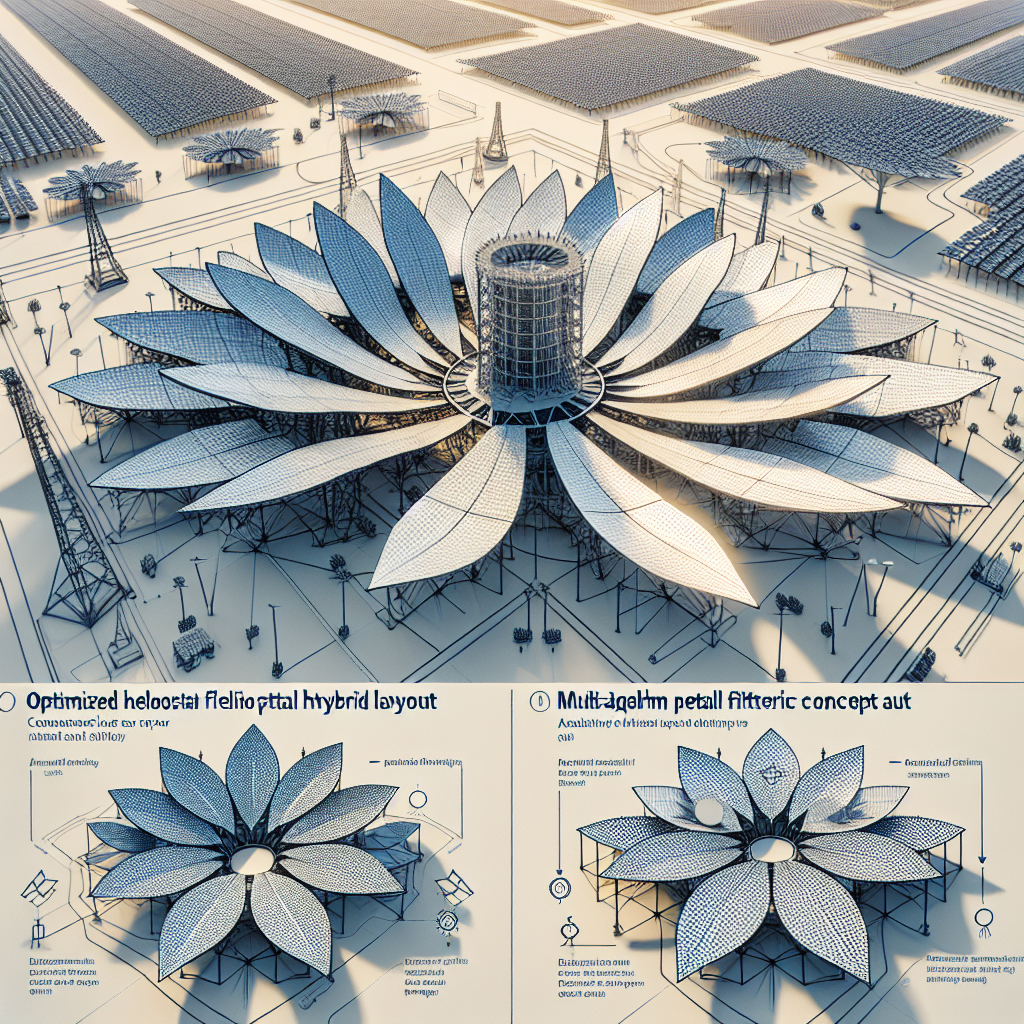-
Table of Contents
- Optimized Heliostat Field Design for Deformable Petal Hybrid Layout in Concentrated Solar Power Using Multi-Algorithm Filtering
- Background: The Role of Heliostat Fields in CSP
- What Are Heliostats?
- Traditional Layout Challenges
- The Deformable Petal Hybrid Layout: A New Paradigm
- Concept and Structure
- Advantages of the Petal Layout
- Multi-Algorithm Filtering: A Breakthrough in Optimization
- The Optimization Challenge
- Filtering 129 Algorithms
- Selected Algorithm: A Tailored Solution
- Case Study: Implementation and Results
- Test Site and Parameters
- Performance Metrics
- Results
- Historical Context and Technological Evolution
- From SEGS to Modern CSP
- Role of Computational Optimization
- Implications for the Future of CSP
- Scalability and Global Deployment
- Integration with Energy Storage
Optimized Heliostat Field Design for Deformable Petal Hybrid Layout in Concentrated Solar Power Using Multi-Algorithm Filtering

As the global demand for clean and sustainable energy continues to rise, Concentrated Solar Power (CSP) has emerged as a promising solution for large-scale renewable electricity generation. A critical component of CSP systems is the heliostat field—an array of mirrors that track the sun and reflect sunlight onto a central receiver. The efficiency and cost-effectiveness of CSP plants are heavily influenced by the design and layout of these heliostat fields. In a groundbreaking study published in Renewable Energy and highlighted by SolarPACES, researchers introduced a novel optimization strategy for designing high-performance heliostat fields using a deformable petal hybrid layout and multi-algorithm filtering. This article delves into the methodology, significance, and implications of this innovative approach.
Background: The Role of Heliostat Fields in CSP
What Are Heliostats?
Heliostats are mirrors that track the sun’s movement and reflect solar radiation onto a central receiver, typically mounted on a tower. The concentrated heat is then used to generate steam, which drives turbines to produce electricity. The layout and orientation of heliostats significantly impact the overall efficiency of a CSP plant.
Traditional Layout Challenges
Conventional heliostat field designs often rely on radial staggered or spiral patterns. While these layouts offer simplicity and ease of implementation, they suffer from limitations such as:
- High cosine losses due to suboptimal mirror angles
- Increased shadowing and blocking between heliostats
- Limited adaptability to irregular terrain
To overcome these challenges, researchers have been exploring more flexible and adaptive field layouts, such as the deformable petal hybrid layout.
The Deformable Petal Hybrid Layout: A New Paradigm
Concept and Structure
The deformable petal hybrid layout divides the heliostat field into multiple petal-shaped sectors. Each sector is independently optimized, allowing for a balance between global pattern orderliness and local adaptability. This modular approach enables the field to conform to complex terrain and varying solar conditions.
Advantages of the Petal Layout
- Flexibility: Each petal can be customized based on local topography and solar incidence angles.
- Scalability: The modular design allows for easy expansion or modification of the field.
- Improved Efficiency: Reduced shadowing and blocking losses lead to higher overall solar capture.
Multi-Algorithm Filtering: A Breakthrough in Optimization
The Optimization Challenge
Designing an optimal heliostat field involves solving a high-dimensional, non-linear optimization problem with multiple conflicting objectives, such as minimizing land use while maximizing energy output. Traditional optimization methods often fall short in handling such complexity.
Filtering 129 Algorithms
To address this, the researchers employed a multi-algorithm filtering approach. They evaluated 129 different high-dimensional optimization algorithms across various performance metrics, including convergence speed, robustness, and solution quality. The filtering process involved:
- Benchmarking each algorithm on standard test functions
- Evaluating performance on simulated heliostat field layouts
- Selecting the top-performing algorithm for final implementation
Selected Algorithm: A Tailored Solution
The final algorithm chosen demonstrated superior performance in handling the deformable petal layout’s complexity. It effectively balanced global search capabilities with local refinement, ensuring both exploration and exploitation of the solution space.
Case Study: Implementation and Results
Test Site and Parameters
The proposed method was tested on a simulated CSP plant located in a high solar irradiance region. Key parameters included:
- Field area: 1.5 km²
- Number of heliostats: 12,000
- Receiver height: 150 meters
- Solar resource: 2,200 kWh/m²/year
Performance Metrics
The optimized deformable petal layout was compared against traditional radial and spiral layouts using the following metrics:
- Annual energy output
- Land use efficiency
- Shadowing and blocking losses
- Cosine efficiency
Results
The deformable petal layout outperformed traditional designs across all metrics:
- Energy output: Increased by 8.7%
- Land use efficiency: Improved by 12.3%
- Shadowing/blocking losses: Reduced by 15.6%
- Cosine efficiency: Enhanced by 9.1%
These improvements translate into significant cost savings and higher return on investment for CSP developers.
Historical Context and Technological Evolution
From SEGS to Modern CSP
The evolution of CSP technology can be traced back to the Solar Energy Generating Systems (SEGS) in California during the 1980s. These early plants used parabolic troughs and basic heliostat fields. Over the decades, advancements in materials, tracking systems, and computational modeling have enabled more sophisticated designs.
Role of Computational Optimization
With the advent of high-performance computing and artificial intelligence, optimization techniques have become central to CSP field design. The use of multi-algorithm filtering represents a significant leap forward, allowing for the systematic selection of the most effective optimization strategy tailored to specific design challenges.
Implications for the Future of CSP
Scalability and Global Deployment
The modular nature of the deformable petal layout makes it ideal for deployment in diverse geographic regions. Whether in the deserts of North Africa or the plateaus of South America, this design can be adapted to local conditions, enhancing the global viability of CSP technology.
Integration with Energy Storage
When combined with thermal energy storage systems, optimized heliostat fields can provide dispatchable solar power, addressing the intermittency issues associated with photovoltaic systems. This positions CSP as a key player in the transition to a low-carbon energy
